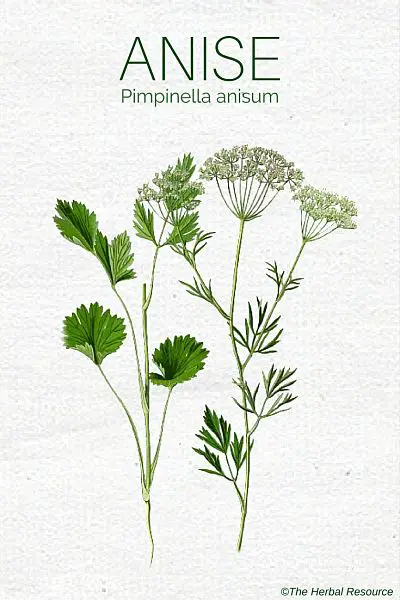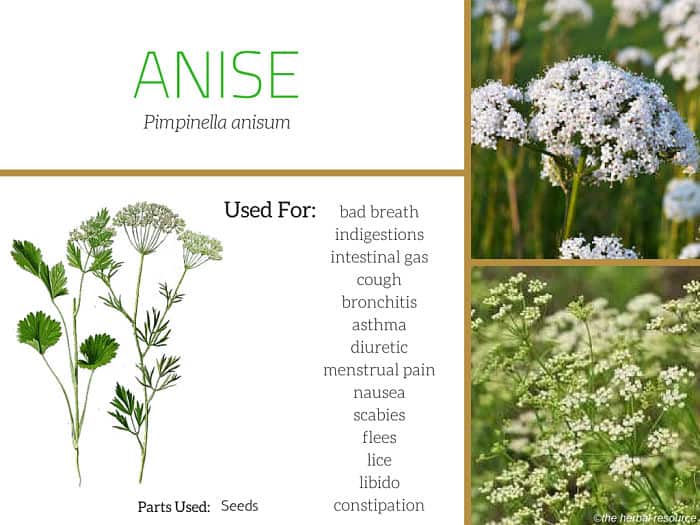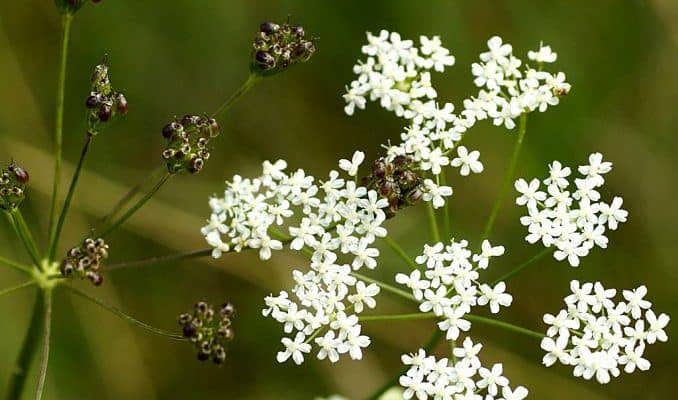Botanical Name: Pimpinella anisum.
The anise seeds have been used since ancient times.
The plant was grown, and its seeds were used as a spice in ancient Egypt, an application later adopted by the Greeks and Romans.
It is primarily the seeds (botanically they are fruits) of the plant and the essential oil extracted from them that are used both as herbal medicines and in cooking.
Also, the flowers and leaves of anise plant are a great addition to salads or as a garnish.
The taste is very distinct and often compared to licorice root and fennel.
Today, it is commonly available in seed, tincture or oil form and is widely used, e.g., as a flavoring in teas, confectionery, desserts, and liquors such as Ouzo, Anisette, Pernod, Pastis and Arrack
The essential oil which is obtained from the crushed seeds is used as an ingredient in many perfumes, lotions, soaps and creams and it is also added to some toothpaste and mouthwashes.
A common misconception is that star anise (Illicium verum), a plant native to China, and anise are the same plant species, but they are not related and belong to different plant families.
Still, they have a resembling aroma and taste, and the chemical composition of their essential oils is very similar.
Anise seeds are used more in Western cuisine, mainly in Greece and France while star anise is more common in Asian dishes.
What is Anise Used For?
Most uses and health benefits of the anise seeds are based on traditional and folk medicine applications, but some have in recent years been validated by scientific methods.
More studies and clinical trials are needed though to confirm the effectiveness of the seeds as herbal medicine fully.
People have used the seeds externally and internally, e.g., the following conditions:
- bad breath
- indigestions
- intestinal gas
- cough
- bronchitis
- asthma
- diuretic
- menstrual pain
- nausea
- scabies
- flees
- lice
- libido
- constipation
Traditional and Modern-Day Uses of Anise Seeds
The seeds are regarded to have antispasmodic, sedative, digestive, antifungal, expectorant, galactagogue, diuretic, carminative, estrogenic, aphrodisiac, bactericidal and fungicidal properties.
When taken internally the seeds have been used to relieve indigestion, colic, gas, halitosis, stomach bloating, abdominal cramps and to remove nausea. 1
The seeds are viewed to have diuretic (increase urine output), and diaphoretic (increased sweating) properties and they have also been used for their antiseptic effects.
Anise oil works as an expectorant, which means it may help in the coughing up of mucus in conditions like asthma, bronchitis, the common cold, and whooping cough. It is, therefore, being used as an ingredient in cough syrups, and lozenges. 2
The essential oil in the seeds contains the substance anethole, which in chemical structure is similar to dopamine, adrenaline, norepinephrine, and ephedrine, all of which have bronchodilatory (dilates the bronchi and bronchioles) properties. 3
The seeds also have mild estrogenic effects most likely due to the presence of diantheole and photoantheole in the oil.
Which explains why the seeds have been used traditionally to promote lactation in nursing mothers, increase libido and to relieve symptoms of premenstrual syndrome. 4
Ointments, lotions, and soaps containing anise oil can help as a natural remedy for oily skin and treat impurities like mild acne.
Since the oil is poisonous to many insects, it has been added to lotions and ointments and used as a natural treatment for scabies and lice infestations. 5

Active Substance and Constituents
The ripe anise seeds contain about 2.5% of the fragrant essential oil (anise oil) that is responsible for most of the beneficial effect associated with them.
The oil consists mostly of anethole and its derivatives, like diantheole and photoantheole. Methyl chavicol and para-methoxyphenylacetone, flavonoids like quercetin, lipids, sterols, and coumarins are also present.
Plant Parts Used
It is the anise seeds (fruits) that are used as a flavoring agent and herbal medicine. The fresh leaves of the plant can be used in salads.
The essential oil has aromatic fragrance and a sweet, strong, distinctive spicy flavor. It is extracted by steam distillation of the seeds (fruits).
The oil is mainly produced in China, Spain, and Guatemala. Today, star anise (Illicum verum) is frequently used instead of anise to get the good anise flavor.
Dosage and Administration
The seeds are often used in the form of tea.
As a tea: First one or two teaspoons of the seeds should be crushed to release the volatile oils then the crushed seeds should soak for five to ten minutes in one cup of boiling water. Many herbalists recommend one cup three times daily.
As an oil: A popular choice is one drop of the anise seed taken internally mixed with half a teaspoonful of honey.
As a tincture: Add ½ – 1 teaspoon of the tincture in a glass of water.
For commercial products containing the anise, the manufacturers’ instructions should be followed.
Potential Side Effects of Anise
Anise oil is not without side effects, as large quantities used internally can cause nausea and vomiting, seizures and even pulmonary edema. Therefore the pure oil should not be used internally as pulmonary edema has occurred after ingestion of such a small quantity as 1-5ml pure anise oil.
Using seeds internally is safe as they do not contain more than 2.5% oil. When applied externally, pure oil can cause skin irritations. Therefore the oil is formulated with other emollients to form an ointment in which the oil is sufficiently diluted to be safe.
As with all natural products allergies can also develop which can potentially be life-threatening. Skin rashes, swelling of skin or tongue, difficulty breathing, and tightness in the chest could indicate an allergic reaction in which case a doctor should be consulted immediately.
Anise should not be used during pregnancy, and a healthcare provider should be consulted before the use by nursing mothers.
Other Common Names
- Aniseed
- Sweet cumin
- Pimpinel seed
- Anis (German)
- Huai-hsiang (Chinese)
- Anis vert (French)
- Anís comun (Spanish)
- Anisruoho (Finnish)
Habitat
The plant’s native origins are unclear, but it is probably native to the Mediterranean area or Asia.
Today it is cultivated in many places around the world with suitable climates such as India, China, Japan, Turkey, Russia, South America, the Southwestern USA, and Mexico.
How to Grow Anise
The plant needs plenty of sunlight and requires a warm climate with an extended frost-free period.
In a temperate climate, the seeds should be sown indoors in late April or early May. The young seedlings are planted, 15 cm apart, in the warmest and sunniest area possible when the danger of night frost is over.
The plant does make demands on its soil composition. The soil should be healthy and calcareous. If the soil is cold and depleted, the plants will have a hard time growing.
It requires a sunny summer to be able to produce mature seeds.
Plant Description
Anise is an annual herb from the family of Umbelliferae, the family of plants like carrot, fennel, and parsnip.
It has light green colored leaves and small white flowers.
Anise should not be confused with the poisonous Japanese star anise (Illicium lanceolatum).
Supporting References
Balch, Phyllis A.: Prescription for Herbal Healing. New York. Avery 2002.
Peirce, Andrea: The American Pharmaceutical Association Practical Guide to Natural Healing. New York. William Morrow and Company, Inc. 1999.
NCBI – National Center for Biotechnology Information – Review of Pharmacological Properties and Chemical Constituents of Pimpinella anisum
Lawless, Julia: The Illustrated Encyclopedia of Essential Oils. Shaftesbury, England. Element Books 1995.
ResearchGate – Reaserch Article – Medicinal benefits of anise seed (Pimpinella Anisum) and Thymus Vulgaris in a sample of healty volunteers
Geelhoed, Glenn & Jean Barilla: Natural Health Secrets From Around the World. New Canaan, Connecticut. Keats Publishing, Inc. 1997. Duke, James A.: The Green Pharmacy Herbal Handbook. Emmaus, Pennsylvania. Rodale / Reach 2000.
Thordur Sturluson
Latest posts by Thordur Sturluson (see all)
- What is the Difference Between Hemp and Marijuana? - June 3, 2019


Leave a Reply